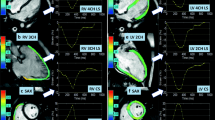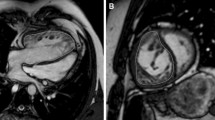Abstract
Anomalous aortic origin of right coronary artery (AAORCA) is associated with myocardial ischemia and sudden cardiac arrest/death. Risk stratification remains challenging and relies upon provocative test results. This study describes the utility of dobutamine stress cardiovascular magnetic resonance (DSCMR) and potential benefit of strain analysis in children with AAORCA. All patients less than 21 years of age with AAORCA who underwent DSCMR between July 2018 and December 2022 were included. Visual wall motion abnormalities (VWMA) at rest and during protocolized increments of dobutamine infusion were assessed. Regional and global left ventricular circumferential (GCS) and radial (GRS) strain using 2-dimension Feature tracking (2D-FT) analysis (cvi42, Circle Cardiovascular Imaging Inc.) were calculated at rest and peak response. Of the total 54 DSCMR studies performed in 51 children with median age (IQR) of 13.5 (11–15) years, FT analysis was reliably performed in 52 (96%) studies. None had VWMA. The absolute change in GCS and GRS from rest to peak dobutamine stress was 4% (1–6%) and 11% (4–18%), respectively. There was no significant difference in GCS and GRS in patients with exertional symptoms vs no/non-exertional symptoms as well as between those considered to be high-risk vs low-risk anatomical features. DSCMR-derived 2D-FT strain analysis is feasible to assess myocardial deformation in children with AAORCA and may enhance this method of provocative testing. Although there were no statically significant differences in GCS and GRS values between high and low-risk subgroups, the absolute change in GCS between rest and peak stress is diminished when compared to normal adult reports.



Similar content being viewed by others
Data Availability
All data and materials as well as software application or custom code support their published claims and comply with field standards.
References
Brothers JA, Frommelt MA, Jaquiss RDB et al (2017) Expert consensus guidelines: anomalous aortic origin of a coronary artery. J Thorac Cardiovasc Surg 153:1440–1457
Jegatheeswaran A, Devlin PJ, McCrindle BW et al (2019) Features associated with myocardial ischemia in anomalous aortic origin of a coronary artery: a Congenital Heart Surgeons’ Society study. J Thorac Cardiovasc Surg 158:822.e3-834.e3
Bigler MR, Ashraf A, Seiler C et al (2021) Hemodynamic relevance of anomalous coronary arteries originating from the opposite sinus of Valsalva—in search of the evidence. Front Cardiovasc Med 7:591326
Jegatheeswaran A, Devlin PJ, Williams WG et al (2020) Outcomes after anomalous aortic origin of a coronary artery repair: a Congenital Heart Surgeons’ Society Study. J Thorac Cardiovasc Surg 160:757.e5-771.e5
Doan TT, Sachdeva S, Bonilla-Ramirez C et al (2023) Ischemia in anomalous aortic origin of a right coronary artery: large pediatric cohort medium-term outcomes. Circ Cardiovasc Interv 16(4):e012631
Doan TT, Molossi S, Sachdeva S et al (2021) Dobutamine stress cardiac MRI is safe and feasible in pediatric patients with anomalous aortic origin of a coronary artery (AAOCA). Int J Cardiol 334:42–48
Molossi S, Agrawal H, Mery CM et al (2020) Outcomes in anomalous aortic origin of a coronary artery following a prospective standardized approach. Circ Cardiovasc Interv 13(2):e008445
Stagnaro N, Moscatelli S, Cheli M, Bondanza S, Marasini M, Trocchio G (2023) Dobutamine stress cardiac MRI in pediatric patients with suspected coronary artery disease. Pediatr Cardiol 44(2):451–462
Qasim A, Doan TT, Dan Pham T et al (2022) Is exercise stress testing useful for risk stratification in anomalous aortic origin of a coronary artery? Semin Thorac Cardiovasc Surg 35(4):759–768
Wang TKM, Dong T, Cremer PC, Najm H, Pettersson G, Jaber WA (2023) Utility of positron emission tomography myocardial perfusion imaging for identifying ischemia and guiding treatment in patients with anomalous coronary arteries. J Nucl Cardiol 30(2):781–789
Schuster A, Paul M, Bettencourt N et al (2013) Cardiovascular magnetic resonance myocardial feature tracking for quantitative viability assessment in ischemic cardiomyopathy. Int J Cardiol 166(2):413–420
Korosoglou G, Elhmidi Y, Steen H et al (2010) Prognostic value of high-dose dobutamine stressmagnetic resonance imaging in 1,493 consecutive patients: assessment of myocardial wall motion and perfusion. J Am Coll Cardiol 56:1225–1234
Schuster A, Kutty S, Padiyath A et al (2011) Cardiovascular magnetic resonance myocardial feature tracking detects quantitative wall motion during dobutamine stress. J Cardiovasc Magn Reason 13:58
Schneeweis C, Qiu J, Schnackenburg B et al (2014) Value of additional strain analysis with feature tracking in dobutamine stress cardiovascular magnetic resonance for detecting coronary artery disease. J Cardiovasc Magn Reason 16(1):72
Schulz-Menger J, Bluemke D, Bremerich J et al (2020) Standardized image interpretation and post-processing in cardiovascular magnetic resonance—2020 update: Society for Cardiovascular Magnetic Resonance (SCMR): Board of Trustees Task Force on Standardized Post-Processing. J Cardiovasc Magn Reason 22(1):19
Cerqueira MD, Weissman NJ, Dilsizian V et al (2002) American heart association writing group on myocardial segmentation and registration for cardiac imaging, standardized myocardial segmentation and nomenclature for tomographic imaging of the heart. A statement for healthcare professionals from the Cardiac Imaging Committee of the Council on Clinical Cardiology of the American Heart Association. Circulation 105:539–542
Lipinski MJ, McVey CM, Berger JS, Kramer CM, Salerno M (2013) Prognostic value of stress cardiac magnetic resonance imaging in patients with known or suspected coronary artery disease: a systematic review and meta-analysis. J Am Coll Cardiol 62:826–838
Schuster A, Morton G, Hussain ST et al (2013) The intra-observer reproducibility of cardiovascular magnetic resonance myocardial feature tracking strain assessment is independent of field strength. Eur J Radiol 82:296–301
Augustine D, Lewandowski AJ, Lazdam M et al (2013) Global and regional left ventricular myocardial deformation measures by magnetic resonance feature tracking in healthy volunteers: comparison with tagging and relevance of gender. J Cardiovasc Magn Reason 15:8
Agrawal H, Wilkinson JC, Noel CV et al (2011) Impaired myocardial perfusion on stress CMR correlates with invasive FFR in children with coronary anomalies. J Invasive Cardiol 33(1):E45–E51
Kawel-Boehm N, Hetzel SJ, Ambale-Venkatesh B et al (2020) Reference ranges (“normal values”) for cardiovascular magnetic resonance (CMR) in adults and children: 2020 update [published correction appears in J Cardiovasc Magn Reson. 2021 Oct 18;23(1):114]. J Cardiovasc Magn Reason 22(1):87
Ferraro AM, Uslenghi A, Lu M et al (2023) Computed tomography angiography (CTA) of anomalous aortic origin of a coronary artery (AAOCA): which measurements are accurate and reliable? J Cardiovasc Comput Tomogr 17(2):130–137
Acknowledgements
The authors appreciate all the staff in the Division of Cardiac Imaging at Children's Health—UT Southwestern Medical Center for their continued support to make this work possible.
Funding
No funding was required for this study.
Author information
Authors and Affiliations
Contributions
Material preparation, data collection and analysis were performed by PD, BS and MF. All authors contributed to the study conception and design. The first draft of the manuscript was written by PD and all authors commented on manuscript revision. All authors read and approved the final manuscript. The authors take responsibility for all aspects of the reliability and freedom from bias of the data presented and their discussed interpretation.
Corresponding author
Ethics declarations
Conflict of interest
The authors declare that they have no conflict of interest.
Ethical Approval
This study was approved by the institutional review board of The University of Texas Southwestern Medical Center.
Consent to Publication
The authors affirm that human research participants and their parents provided informed consent for publications of images.
Additional information
Publisher's Note
Springer Nature remains neutral with regard to jurisdictional claims in published maps and institutional affiliations.
Rights and permissions
Springer Nature or its licensor (e.g. a society or other partner) holds exclusive rights to this article under a publishing agreement with the author(s) or other rightsholder(s); author self-archiving of the accepted manuscript version of this article is solely governed by the terms of such publishing agreement and applicable law.
About this article
Cite this article
Doctor, P., Sharma, B., Greil, G. et al. Dobutamine Stress Cardiovascular Magnetic Resonance Derived 2-Dimension Feature Tracking Strain Analysis in Pediatric Population with Anomalous Aortic Origin of Right Coronary Artery. Pediatr Cardiol 45, 520–528 (2024). https://doi.org/10.1007/s00246-023-03401-9
Received:
Accepted:
Published:
Issue Date:
DOI: https://doi.org/10.1007/s00246-023-03401-9




